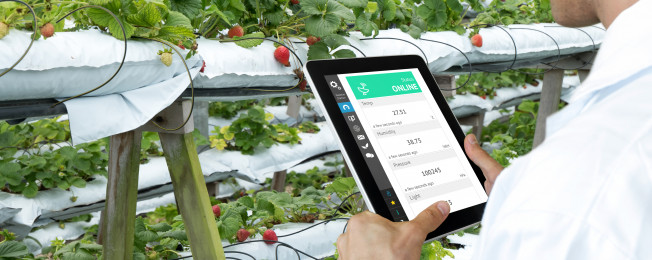At least 795 million people go hungry around the world every day - and every day the world’s population grows ever larger.
The UN projects there will be 8.5 billion of us by 2030, a rise of one billion in just 13 years. Making sure we can produce and distribute enough food to sustain everyone is one of the greatest challenges facing humanity.
And it is a challenge we will only be able to meet if we are willing to rethink the way we do food.
Food for thought
Of course, lack of food is about hunger, but it is also about so much more. A shortage of food leads to a life of poverty for individuals, families and communities.
Malnutrition is the largest contributor to disease in the world, and nearly half of all deaths in children under five are a result of it. That’s three million young lives lost every year.
And the one in four children worldwide that are living with malnourishment often have reduced school performance and even impaired brain development.
Our existing model of food production is doing terrible damage to the environment too. Food systems account for 70% of freshwater use and consume 30% of the world’s available energy, much of it in fossil fuels.
Agriculture accounts for 20-30% of global greenhouse emissions – a bitter irony as climate change threatens to reduce crop yields by 25% or more.
Agriculture is also the most significant driver of deforestation, which rose 51% from 2015 to 2016. This contributes to climate change as well as causing loss of habitat and the resulting fall in biodiversity.
Food production is so intertwined with health, energy consumption, the environment, and education that we can’t address challenges in those areas without considering the global food system as well.
We simply cannot continue with business as usual.
Investing in the future of food
While it is impossible to pretend that there are simple answers to these problems, new technology offers some of the most promising solutions.
A recent report from the World Economic Forum suggests that the planet’s food systems could look very different by 2030 if sufficient investment in agricultural technology is made now.
And some of that investment is already happening. Between 2010 and 2017, $14 billion was invested in 1,000 startups related to food systems. That sounds like a huge amount and is certainly a good start - but it is much smaller when you look at that figure in context. Investors poured $145 billion into 18,000 healthcare startups during the same period, for example.
So much more could be achieved with increased investment. Possible improvements include shrinking the environmental burden of farming and improving crop diversity, so diets are more nutritious, and agriculture is more sustainable. This would help farmers produce more food while increasing their profits, making food distribution safer and more efficient.
The benefits of blockchain, AI and machine learning
Some of the future benefits of new technology are already becoming clear.
Precision agriculture methods – which make use of machine learning technologies and the Internet of Things - will optimize land and water use for different crops and farming conditions, lowering costs and increasing production while reducing freshwater use.
Applying big data analytics to insurance statistics about farming conditions and yields will lower the risks for farmers who want to try new crops and agricultural methods.
Sensor-enabled food transportation will reduce wasted food by letting companies in the food supply chain adjust temperature, humidity, and other transportation conditions in real time.
Sensors and blockchain technology will improve supply chain transparency, further reducing food waste and loss while preventing tampering, counterfeiting, and mislabeling.
Advanced batteries and other off-grid ways to generate and store renewable energy will make farming equipment both more environmentally friendly and less expensive to operate, while letting farmers sell excess electricity back to the grid as an additional “crop”.
We’re also likely to see new farming methods designed to increase yield and grow food in places unfriendly to traditional agriculture. “Plantscrapers” might tuck vertical farms into urban buildings in a symbiosis where the plants provide food and cleaner air in exchange for human-created heat and fertilizer.
Rethinking the menu
It’s not just farmers and suppliers that will need to change their habits though. Consumers will also have to make some significant changes to their diet.
For example, there’s a growing body of evidence that the earth won’t be able to sustain the environmental footprint of large-scale cattle production. Growing sufficient food for livestock requires a tremendous amount of land which could be more efficiently used for crops. An estimated 75% of the world’s agricultural land is providing food for meat production.
Meat production is also extremely water-intensive; producing one kilo of meat requires between 5,000 and 20,000 liters of water, while producing one kilo of wheat requires much less—between 500 and 4,000 liters.
So we could find ourselves eating far less beef, or none at all — or we could start eating burgers from beef that was never on the hoof at all but cultured in a lab. The milk we put in our morning coffee might come from genetically modified yeast rather than cows. And to get the necessary protein in our diets, the morning might start with a muffin made from cricket flour.
New technologies will make sure that tomorrow’s plant-derived, cultured, and engineered foods are every bit as nutritious — and tasty — as the ones we already enjoy, while reducing the environmental damage caused by animal agriculture.
Some of these ideas may sound farfetched but influential investors like Richard Branson and Bill Gates are already betting millions on them.
A time for change
Technology and a shift in diet, of course, won’t be enough to ensure a well-fed future for everyone.
Changing the global system will take time and every change has implications, generating questions such as who controls what data, and what other jobs might be available for people who no longer need to spend their time farming.
There are endless variables involved such as weather patterns, political considerations, demands for different types of food, availability of loans, and access to markets. It will take time and an element of trial and error to find out what works where.
In the end, feeding 8.5 billion people by 2030 is as much a matter of mindset as it is of technology. To get there, we need to shift our ingrained assumptions about how the global food system works, how we make sure everyone has enough to eat, and most of all, why it matters.
That demands that we expand our options beyond what we already know and start thinking about things we haven’t yet tried.


